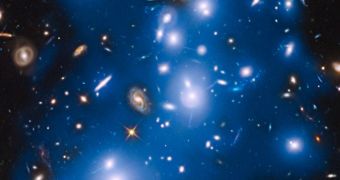Just in time for Halloween, astronomers with the Space Telescope Science Institute in the US announced to the world that, several billion years ago, a cosmic massacre played out in a distant galaxy cluster.
Thus, information obtained with the help of NASA's Hubble Space Telescope indicates that, a long, long time ago, at least six galaxies that were part and parcel of Pandora's Cluster got torn to pieces and literally spilled their guts.
The Space Telescope Science Institute astronomers say that all that was left of these galaxies were orphaned stars that are now aimlessly wandering around space, probably looking for a new home.
Forensic evidence of the galactic drama
First off, it need be said that Pandora's Cluster, which also goes by the name of Abell 2744, sits at a distance of roughly 4 billion light-years from our planet. It packs about 500 galaxies, and holds the mass equivalent of about 4 trillion Suns.
In a recent paper in The Astrophysical Journal, scientists explain that, having analyzed data obtained with the help of NASA's Hubble Space Telescope, they pinned down traces of light originating from some 200 billion orphaned stars.
These stars are believed to be the remains of at least 6 galaxies that used to be part of Pandora's Cluster and that were ripped apart by gravitational forces over the course of 6 billion years. When in their heydays, the now defunct galaxies were about the size of the Milky Way.
The 200 billion ghost stars documented wandering around Abell 2744 are estimated to account for about 10% of the galaxy cluster's brightness. The light they emit makes up the darker blue regions in the image accompanying this article.
Interestingly enough, most of these orphaned stars appear to pack a significant amount of heavier elements such as carbon, nitrogen and oxygen. As explained by astronomers, this means that they are second- or maybe even third-generation stars enriched with elements from the universe's first stars.
Not the only ghost stars in the universe
The anatomy of Pandora's Cluster was studied as part of a research program known as Frontier Fields. It is understood that as many as 5 other galaxy clusters have so far been included in this program, and that astronomers will soon turn their attention to studying their makeup.
Seeing how galaxies are bound to get ripped apart when sucked into massive clusters and exposed to major gravitational pulls, scientists expect that they will find evidence of ghost stars in the other clusters they wish to study as well.
Commenting on the importance of this investigation into the anatomy of Pandora's Cluster, researcher Ignacio Trujillo said, “The Hubble data revealing the ghost light are important steps forward in understanding the evolution of galaxy clusters.”
“The results are in good agreement with what has been predicted to happen inside massive galaxy clusters,” added Mireia Montes, a scientist currently working with the Instituto de Astrofísica de Canarias (IAC), La Laguna, Tenerife, Spain.

 14 DAY TRIAL //
14 DAY TRIAL //